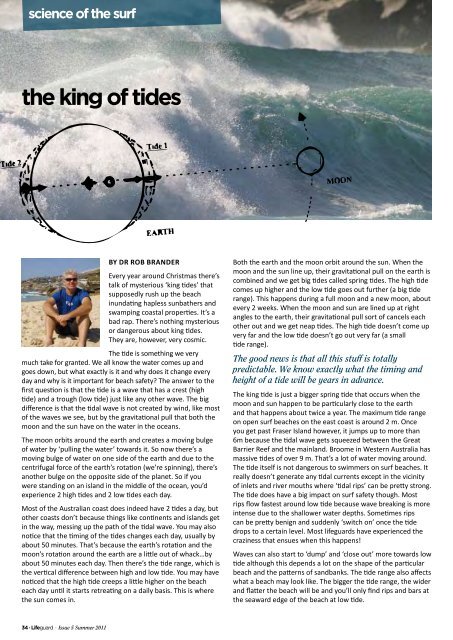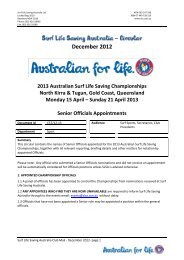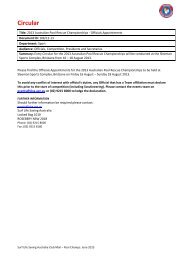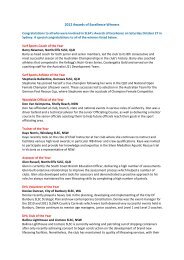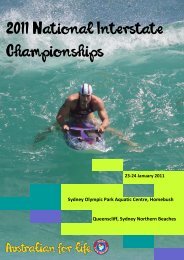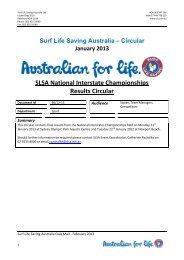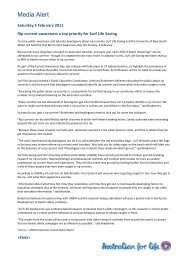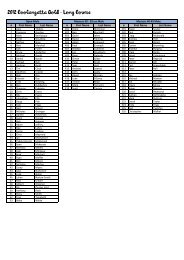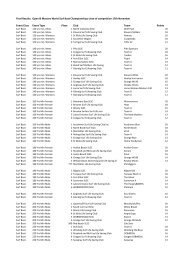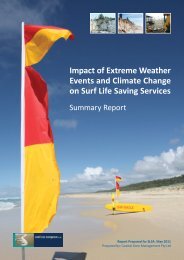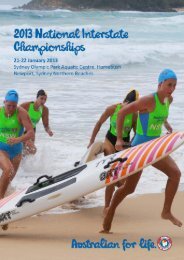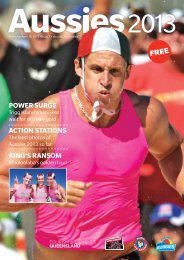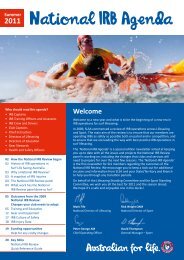Australian Lifeguard magazine - Surf Life Saving Australia
Australian Lifeguard magazine - Surf Life Saving Australia
Australian Lifeguard magazine - Surf Life Saving Australia
Create successful ePaper yourself
Turn your PDF publications into a flip-book with our unique Google optimized e-Paper software.
science of the surfthe king of tidesBy Dr rOb BranderEvery year around Christmas there’stalk of mysterious ‘king tides’ thatsupposedly rush up the beachinundating hapless sunbathers andswamping coastal properties. It’s abad rap. There’s nothing mysteriousor dangerous about king tides.They are, however, very cosmic.The tide is something we verymuch take for granted. We all know the water comes up andgoes down, but what exactly is it and why does it change everyday and why is it important for beach safety? The answer to thefirst question is that the tide is a wave that has a crest (hightide) and a trough (low tide) just like any other wave. The bigdifference is that the tidal wave is not created by wind, like mostof the waves we see, but by the gravitational pull that both themoon and the sun have on the water in the oceans.The moon orbits around the earth and creates a moving bulgeof water by ‘pulling the water’ towards it. So now there’s amoving bulge of water on one side of the earth and due to thecentrifugal force of the earth’s rotation (we’re spinning), there’sanother bulge on the opposite side of the planet. So if youwere standing on an island in the middle of the ocean, you’dexperience 2 high tides and 2 low tides each day.Most of the <strong><strong>Australia</strong>n</strong> coast does indeed have 2 tides a day, butother coasts don’t because things like continents and islands getin the way, messing up the path of the tidal wave. You may alsonotice that the timing of the tides changes each day, usually byabout 50 minutes. That’s because the earth’s rotation and themoon’s rotation around the earth are a little out of whack…byabout 50 minutes each day. Then there’s the tide range, which isthe vertical difference between high and low tide. You may havenoticed that the high tide creeps a little higher on the beacheach day until it starts retreating on a daily basis. This is wherethe sun comes in.Both the earth and the moon orbit around the sun. When themoon and the sun line up, their gravitational pull on the earth iscombined and we get big tides called spring tides. The high tidecomes up higher and the low tide goes out further (a big tiderange). This happens during a full moon and a new moon, aboutevery 2 weeks. When the moon and sun are lined up at rightangles to the earth, their gravitational pull sort of cancels eachother out and we get neap tides. The high tide doesn’t come upvery far and the low tide doesn’t go out very far (a smalltide range).The good news is that all this stuff is totallypredictable. We know exactly what the timing andheight of a tide will be years in advance.The king tide is just a bigger spring tide that occurs when themoon and sun happen to be particularly close to the earthand that happens about twice a year. The maximum tide rangeon open surf beaches on the east coast is around 2 m. Onceyou get past Fraser Island however, it jumps up to more than6m because the tidal wave gets squeezed between the GreatBarrier Reef and the mainland. Broome in Western <strong>Australia</strong> hasmassive tides of over 9 m. That’s a lot of water moving around.The tide itself is not dangerous to swimmers on surf beaches. Itreally doesn’t generate any tidal currents except in the vicinityof inlets and river mouths where ‘tidal rips’ can be pretty strong.The tide does have a big impact on surf safety though. Mostrips flow fastest around low tide because wave breaking is moreintense due to the shallower water depths. Sometimes ripscan be pretty benign and suddenly ‘switch on’ once the tidedrops to a certain level. Most lifeguards have experienced thecraziness that ensues when this happens!Waves can also start to ‘dump’ and ‘close out’ more towards lowtide although this depends a lot on the shape of the particularbeach and the patterns of sandbanks. The tide range also affectswhat a beach may look like. The bigger the tide range, the widerand flatter the beach will be and you’ll only find rips and bars atthe seaward edge of the beach at low tide.34 · <strong><strong>Life</strong>guard</strong> · Issue 5 Summer 2011


